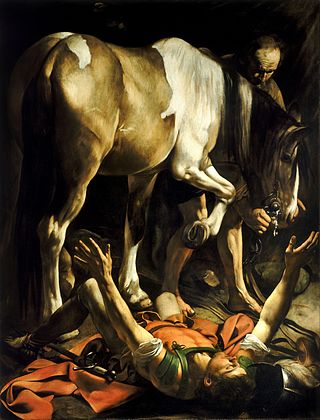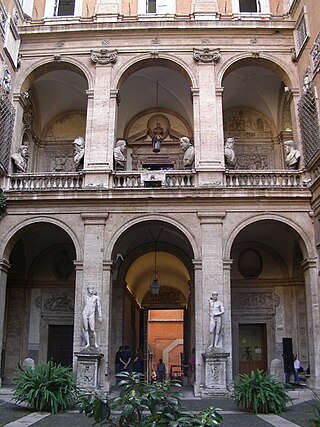
Michelangelo Merisi da Caravaggio, known mononymously as Caravaggio, was an Italian painter active in Rome for most of his artistic life. During the final four years of his life, he moved between Naples, Malta, and Sicily until his death. His paintings have been characterized by art critics as combining a realistic observation of the human state, both physical and emotional, with a dramatic use of lighting, which had a formative influence on Baroque painting.

The Conversion on the Way to Damascus is a work by Caravaggio, painted in 1601 for the Cerasi Chapel of the church of Santa Maria del Popolo, in Rome. Across the chapel is a second Caravaggio depicting the Crucifixion of Saint Peter. On the altar between the two is the Assumption of the Virgin Mary by Annibale Carracci.

The Crucifixion of Saint Peter is a work by Michelangelo Merisi da Caravaggio, painted in 1601 for the Cerasi Chapel of Santa Maria del Popolo in Rome. Across the chapel is a second Caravaggio work depicting the Conversion of Saint Paul on the Road to Damascus (1601). On the altar between the two is the Assumption of the Virgin Mary by Annibale Carracci.

The Inspiration of Saint Matthew (1602) is a painting by the Italian Baroque master Michelangelo Merisi da Caravaggio. Commissioned by the French Cardinal Matteo Contarelli, the canvas hangs in Contarelli chapel altar in the church of the French congregation San Luigi dei Francesi in Rome, Italy.

The Martyrdom of Saint Matthew is a painting by the Italian master Michelangelo Merisi da Caravaggio. It is located in the Contarelli Chapel of the church of the French congregation San Luigi dei Francesi in Rome, where it hangs opposite The Calling of Saint Matthew and beside the altarpiece The Inspiration of Saint Matthew, both by Caravaggio. It was the first of the three to be installed in the chapel, in July 1600.

Caravaggio created one of his most admired altarpieces, The Entombment of Christ, in 1603–1604 for the second chapel on the right in Santa Maria in Vallicella, a church built for the Oratory of Saint Philip Neri. A copy of the painting is now in the chapel, and the original is in the Vatican Pinacoteca. The painting has been copied by artists as diverse as Rubens, Fragonard, Géricault and Cézanne.

The Madonna and Child with St. Anne or Madonna and the Serpent, is one of the mature religious works of the Italian Baroque master Caravaggio, painted in 1605–1606, for the altar of the Archconfraternity of the Papal Grooms in the Basilica of Saint Peter and taking its theme from Genesis 3:15. The painting was briefly exhibited in the parish church for the Vatican, Sant'Anna dei Palafrenieri, before its removal, due to its unorthodox portrayal of the Virgin Mary. There are a lot of reasons why the piece may have been removed, such as the nudity of the child Jesus and the Virgin Mary revealing too much of her breast. The reputation of the model that Caravaggio used to portray the Virgin Mary could be another reason as to why this altarpiece was withdrawn. The altarpiece was sold to Cardinal Scipione Borghese and now hangs in his palazzo.

The Basilica of Saint Augustine in Camp Martius, commonly known as Basilica of Saint Augustine is a Catholic titular minor basilica in the Campus Martius area of Rome, Italy. Dedicated to Saint Augustine of Hippo it serves as the motherhouse of the Augustinian Friars.

Judith Beheading Holofernes is a painting of the biblical episode by Caravaggio, painted in c. 1598–1599 or 1602, in which the widow Judith stayed with the Assyrian general Holofernes in his tent after a banquet then decapitated him after he passed out drunk. The painting was rediscovered in 1950 and is part of the collection of the Galleria Nazionale d'Arte Antica in Rome. The exhibition 'Dentro Caravaggio' Palazzo Reale, Milan, suggests a date of 1602 on account of the use of light underlying sketches not seen in Caravaggio's early work but characteristic of his later works. The exhibition catalogue also cites biographer artist Giovanni Baglione's account that the work was commissioned by Genoa banker Ottavio Costa.

The Adoration of the Shepherds is an oil on canvas painting by the Italian artist Michelangelo Merisi, commonly known as Caravaggio. The Adoration of the Shepherds measures 83.07 x 123.62 in. It was commissioned for the Capuchin Franciscans and was painted in Messina for the Church of Santa Maria degli Angeli in 1609 just one year before the artist's death. It is now in the Interdisciplinary Regional Museum of Messina.

Two versions of Medusa were created by Michelangelo Merisi da Caravaggio, one in 1596 and the other in ca. 1597. Both depict the moment from Greek mythology in which the Gorgon Medusa is killed by the demigod Perseus, but the Medusas are also self-portraits. Due to its bizarre and intricate design, the painting is said to display Caravaggio's unique fascination with violence and realism. The Medusa was commissioned by the Italian diplomat Francesco Maria del Monte, who planned to gift the commemorative shield to Ferdinando I de' Medici and have it placed in the Medici collection. It is now located in the Uffizi Museum in Florence without signature.

Boy with a Basket of Fruit is an oil on canvas painting generally ascribed to Italian Baroque master Michelangelo Merisi da Caravaggio, created c. 1593. It is held in the Galleria Borghese, in Rome.

The Cardsharps is a painting by the Italian Baroque artist Michelangelo Merisi da Caravaggio. The original is generally agreed to be the work acquired by the Kimbell Art Museum in 1987, although Caravaggio may have painted more than one version.

Portrait of a Courtesan was a painting by the Baroque master Michelangelo Merisi da Caravaggio. Painted between 1597 and 1599, it was destroyed in Berlin in 1945 and is known only from photographs. It has been suggested that the portrait represents the goddess Flora.
John the Baptist was the subject of at least eight paintings by the Italian Baroque artist Michelangelo Merisi da Caravaggio (1571–1610).

Martha and Mary Magdalene is a painting by the Italian Baroque master Michelangelo Merisi da Caravaggio. It is in the Detroit Institute of Arts. Alternate titles include Martha Reproving Mary, The Conversion of the Magdalene, and the Alzaga Caravaggio.

Portrait of Maffeo Barberini is a painting by the Italian Baroque master Michelangelo Merisi da Caravaggio. First cataloged in 1963 by Roberto Longhi, one of Italy’s foremost 20th-century art historians, the painting had been in a private collection for decades, largely inaccessible to scholars and had not been featured in any of the major Caravaggio exhibitions. In November, 2024 the painting went on display at the Palazzo Barberini.

The Cerasi Chapel or Chapel of the Assumption is one of the side chapels in the left transept of the Basilica of Santa Maria del Popolo in Rome. It contains significant paintings by Michelangelo Merisi da Caravaggio and Annibale Carracci, two of the most important masters of Italian Baroque art, dating from 1600 to 1601.

Bartolomeo Manfredi was an Italian painter, a leading member of the Caravaggisti of the early 17th century.

The Palazzo Mattei di Giove is the most prominent among a group of Mattei houses that forms the insula Mattei in Rome, Italy, a block of buildings of many epochs.



















